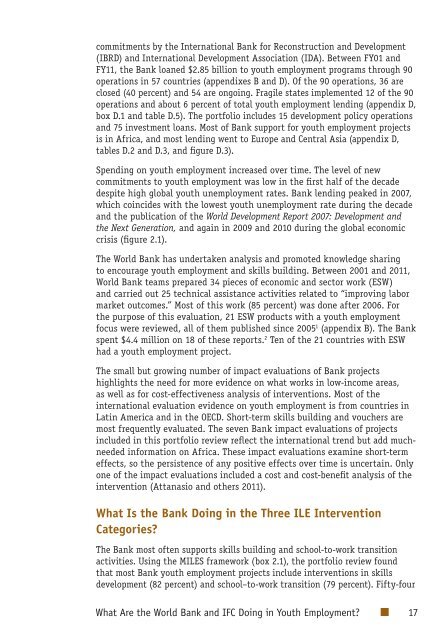Youth Employment Programs - Independent Evaluation Group
Youth Employment Programs - Independent Evaluation Group
Youth Employment Programs - Independent Evaluation Group
Create successful ePaper yourself
Turn your PDF publications into a flip-book with our unique Google optimized e-Paper software.
commitments by the International Bank for Reconstruction and Development(IBRD) and International Development Association (IDA). Between FY01 andFY11, the Bank loaned $2.85 billion to youth employment programs through 90operations in 57 countries (appendixes B and D). Of the 90 operations, 36 areclosed (40 percent) and 54 are ongoing. Fragile states implemented 12 of the 90operations and about 6 percent of total youth employment lending (appendix D,box D.1 and table D.5). The portfolio includes 15 development policy operationsand 75 investment loans. Most of Bank support for youth employment projectsis in Africa, and most lending went to Europe and Central Asia (appendix D,tables D.2 and D.3, and figure D.3).Spending on youth employment increased over time. The level of newcommitments to youth employment was low in the first half of the decadedespite high global youth unemployment rates. Bank lending peaked in 2007,which coincides with the lowest youth unemployment rate during the decadeand the publication of the World Development Report 2007: Development andthe Next Generation, and again in 2009 and 2010 during the global economiccrisis (figure 2.1).The World Bank has undertaken analysis and promoted knowledge sharingto encourage youth employment and skills building. Between 2001 and 2011,World Bank teams prepared 34 pieces of economic and sector work (ESW)and carried out 25 technical assistance activities related to “improving labormarket outcomes.” Most of this work (85 percent) was done after 2006. Forthe purpose of this evaluation, 21 ESW products with a youth employmentfocus were reviewed, all of them published since 2005 1 (appendix B). The Bankspent $4.4 million on 18 of these reports. 2 Ten of the 21 countries with ESWhad a youth employment project.The small but growing number of impact evaluations of Bank projectshighlights the need for more evidence on what works in low-income areas,as well as for cost-effectiveness analysis of interventions. Most of theinternational evaluation evidence on youth employment is from countries inLatin America and in the OECD. Short-term skills building and vouchers aremost frequently evaluated. The seven Bank impact evaluations of projectsincluded in this portfolio review reflect the international trend but add muchneededinformation on Africa. These impact evaluations examine short-termeffects, so the persistence of any positive effects over time is uncertain. Onlyone of the impact evaluations included a cost and cost-benefit analysis of theintervention (Attanasio and others 2011).What Is the Bank Doing in the Three ILE InterventionCategories?The Bank most often supports skills building and school-to-work transitionactivities. Using the MILES framework (box 2.1), the portfolio review foundthat most Bank youth employment projects include interventions in skillsdevelopment (82 percent) and school–to-work transition (79 percent). Fifty-fourWhat Are the World Bank and IFC Doing in <strong>Youth</strong> <strong>Employment</strong>? 17
















